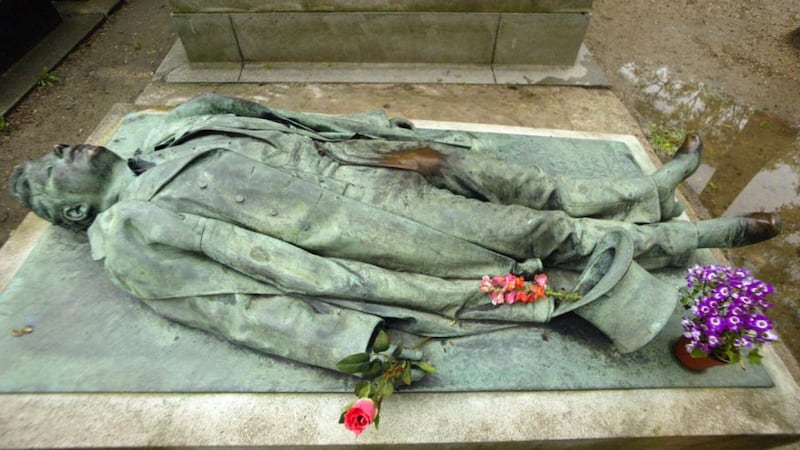It’s not often I find myself agreeing with the 16th-century Council of Trent, God knows. But every time I walk down Dublin’s Andrew Street these days and see the statue of Molly Malone having her bosoms fondled by tourists, the argument for adding clothes to public sculptures seems more persuasive.
Unlike the ones that worried Pope Pius IX, Molly is not even naked. This hasn’t stopped her becoming part of a 21st-century global cult whereby the prominent parts of any city’s bronze artworks have to be rubbed by visitors, for luck and other supposed benefits.
You might think that, in the era of #MeToo, people would hesitate to be seen in broad daylight groping the breasts – even in effigy – of a woman they’d never met before. But on the contrary, it seems to be all-but obligatory now for tourists of every gender to maul her, while being photographed in the act.
The Council of Trent was more concerned with the nether parts of statues and paintings, especially in the work of Michelangelo. Hence the Fig Leaf Campaign of 1563, which revived a fashion from the Garden of Eden by adding foliage to genitalia. Loincloths were also sometimes provided. So famous was the painter Daniele da Volterra (1509-1566) for improving the wardrobe of the artistically underdressed, he was nicknamed Il Braghettone, the breeches-maker.
High note: Colette Sheridan on unique exhibition celebrating 170 years of Cork Opera House
‘The cadet was now descending rapidly towards Cavan without any training in the use of a parachute’
Alison Healy on some regrettable wedding celebration traditions
Ray Burke on the legacy of multi-talented doctor and author Oliver St John Gogarty
Fig leaves might not suit Molly so well. But perhaps a strategically placed garland of flowers could protect her from the worst excesses of tourism’s high season. Either that or the city council might consider erecting a fence around her.
They wouldn’t be the first to take such a drastic measure in preventing the sexual abuse of a statue. Consider the case of Victor Noir, compared with whose effigy Molly gets off lightly.
Unlike her (probably), Noir was a real person, albeit under a pseudonym: he had been born Yvan Salmon in 1848. He was a real journalist too, until January 11th, 1870, when Prince Napoleon shot him dead. After which, mysteriously, he became the focus of a fertility cult.
The tradition arose – perhaps literally – from the bronze likeness on his tomb at Pere Lachaise, which depicts him as he lay dead, but with a notable protuberance in his upper trouser region.

It somehow became the custom for Parisian women seeking maternity to place flowers in his adjacent, upturned hat, then kiss his lips and, well, rub the relic. As a Google picture search reveals, pilgrims have occasionally gone further, straddling him in the kind of clothes that would themselves have worried the Council of Trent.
All this being in a cemetery, however, it eventually impelled Pere Lachaise to erect a protective fence. But this was soon pulled down again, supposedly by the angry women of Paris (with some encouragement from a TV show).
Last time I checked, the statue of James Joyce in Dublin’s North Earl Street had yet to spawn a rubbing ritual
Most cities at least tolerate the rubbing of statues. Indeed, having at least one statue to rub seems to be an increasingly essential part of their tourist offering. Examples include the sculpture of Juliet in Verona, whose right bosom supposedly confers luck; David Hume in Edinburgh (right toe, wisdom); John Harvard in Boston (left shoe, career success); Wall Street Bull in New York (horns, nose, and testicles, luck in investment); and so on.
From the perspective of taste, even Victor Noir’s is not the worst case. On Castle Hill in Prague, near the Toy Museum, is a 1960s statue of a naked adolescent boy, the penis of which has been gradually shone to a lustre exceeding even that of Molly Malone’s cleavage.
Strange to say, last time I checked, the statue of James Joyce in Dublin’s North Earl Street had yet to spawn a rubbing ritual. But in Ulysses, the writer unwittingly reminded us that, as faddish as this modern phenomenon appears, it has ancient roots.
During the chapter set in Holles Street hospital, while reflecting on the human reproductive cycle, he mentions a “St Foutinus” and “his engines”. Even Joycean detectives were long mystified by this reference to an apparently fictional holy man.
Then they finally traced it to a Foutin of Lyon, an early French saint who had been all-but expunged from the record because his cult became mixed up with that of a “priapic, pre-Christian god”. This resulted in a ceremony whereby, on effigies of Foutin, believers poured wine over the area euphemised by Joyce as his “engines”. Then, after waiting for the run-off to turn to vinegar, they used it as a potion against infertility.
The bronze Molly Malone has become a fertility symbol too, in her own way. But even for the Irish weather, usually, she’s a little underdressed. To protect her from the combined depredations of tourism and rain, I believe there is a case for a modern Il Braghettone to give her another layer.
















